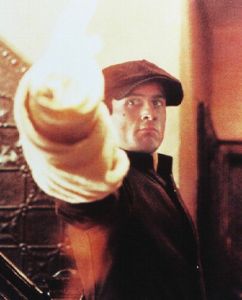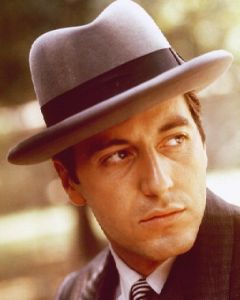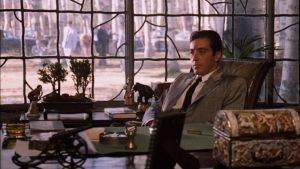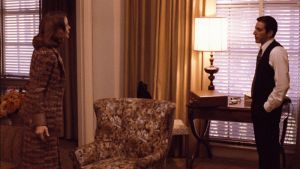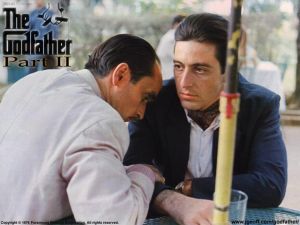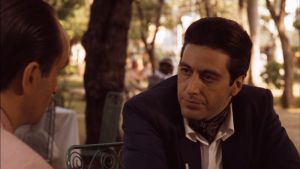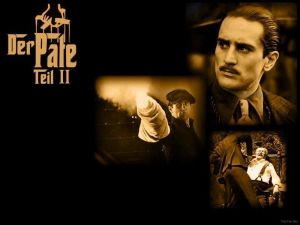The Godfather II
The Godfather Part II is a sequel and a prequel to The Godfather, which is released in 1974, also directed by Francis Ford Coppola and adapted from the same name of the book. It describes the story of the Corleone family following the events of the first film while also depicts the rise to power of the young Vito Corleone. It is an amazingly intricate, symmetrical tragedy that touches upon several chapters of 20th-century history and makes a strong case that our destinies are written long before we're born.
Directed by: Francis Ford Coppola
Produced by: Francis Ford Coppola
Co-Producers: Gray Frederickson Fred Roos
Written by Novel: Mario Puzo
Screenplay: Mario Puzo Francis Ford Coppola
Editing by: Barry Malkin Richard Marks Peter Zinner
Distributed by: Paramount Pictures
Release dates:
NYC première:
December 12, 1974
LA première:
December 18, 1974
US General:
December 20, 1974
Running time theatrical: 200:45
Country: United States
Language: English Sicilian
Genre: feature crime
Coppola tells two stories in The Godfather II: the roots and rise of a young Don Vito and the ascension of Michael as the new Don.
In the early 1900s, the child Vito flees his Sicilian village for America after the local Mafia kills his family. Vito struggles to make a living, legally or illegally, for his wife and growing brood in Little Italy, killing the local Black Hand Fanucci after he demands his customary cut of the tyro's business. With Fanucci gone, Vito's communal stature grows.
Now come back to the present, wanting to avoid the disgrace of the family, Michael takes over and swears to make the family business legitimate. However, he has a difficult time doing this. Michael tries his best to run the family according to his father's advice, but as the times change, so does the family, and Michael becomes overwhelmed. When his brother Fredo betrays him to another business partner, and Michael becomes very angry.
Then come back to the past, Vito Corleone is in his time as the Godfather, a term of the utmost respect and honor for Italians. In 1925, Vito visits Sicily for the first time since leaving for America. He is introduced to the elderly Don Ciccio by Don Tommasino, the murderer of his father, brother, and mother. Then Vito kills him and avenges his families’s death..
Come back to the present again, Michael is in an extreme conflict with his wife, Kay, over the family business. He is angry with her for wanting to end the family and for wanting to take away his children by getting an abortion in order to end it. Michael's situation with Fredo gets worse and worse. Then Michael gets his hit man to kill Fredo. The film ends with Michael sitting outside the Lake Tahoe compound, alone in contemplative silence.
Al Pacino as Michael Corleone, Marlon Brando initially agreed to return for the brief but important birthday flashback sequence, but the actor, feeling mistreated by the board at Paramount, failed to show up for the single day's shooting. Coppola rewrote the scene that same day.
Robert De Niro as Young Vito Corleone
Robert Duvall as Tom Hagen
Diane Keaton as Kay Corleone
John Cazale as Fredo Corleone
Talia Shire as Connie Corleone
Morgana King as Carmella Corleone
Marianna Hill as Deanna Corleone
Roman Coppola as Young Santino Corleone
Michael V. Gazzo as Frankie Pentangeli, Richard Castellano, who portrayed Pete Clemenza in the first film, also declined to return, as Castellano and the producers could not reach agreement on Castellano's demands that he be allowed to write the character's dialogue in the film. Clemenza's role was subsequently filled by his successor, Frank Pentangeli.
G. D. Spradlin as Senator Pat Geary
Richard Bright as Al Neri
Gastone Moschin as Don Fanucci
Bruno Kirby as Young Peter Clemenza
Frank Sivero as Young Genco Abbandando
John Megna as Young Hyman Roth
John Aprea as Young Sal Tessio
James Caan as Sonny Corleone (cameo), James Caan agreed to reprise the role of Sonny in the birthday flashback sequence on the condition that for the single scene he be paid the same amount he received for the entire last film. He got his wish.
Abe Vigoda as Salvatore Tessio (cameo)
Gianni Russo as Carlo Rizzi (cameo)
Dominic Chianese as Johnny Ola,
Giuseppe Sillato as Don Francesco Ciccio
Julian Voloshin as Sam Roth
Larry Guardino as Vito's Uncle
Danny Aiello as Tony Rosato
The Godfather (1972) had been such a box-office and critical sensation, that Paramount Studios wanted to make a follow-up quickly. Francis Ford Coppola, who had directed the first film, was not interested because the studio had nearly fired him from the first production several times. He suggested Martin Scorsese but Paramount refused. Coppola finally gave in when the studio agreed to his demands. Those demands were: the sequel should be interconnected with the first film with the intention of later showing them together; he should be allowed to direct his own script of The Conversation (1974); he should be allowed to direct a production for the San Francisco Opera; and he should be allowed to write the screenplay for The Great Gatsby (1974) - all prior to production of the sequel for a Christmas 1974 release. Coppola later remembered, "I looked at the calendar and realized that I had three months to write a two-hundred-page screenplay for Godfather II, and then go right into pre-production."
Coppola's idea for the sequel would be to arrange the ascension of the family under Vito Corleone with the decline of the family under his son Michael in parallel. I had always wanted to write a screenplay that told the story of a father and a son at the same age. They were both in their thirties and I would integrate the two stories. In order not to merely make Godfather I over again, I gave Godfather II this double structure by extending the story in both the past and in the present."
The Godfather Part II was shot between October 1, 1973 and June 19, 1974, the last major American motion picture to be filmed in Technicolor. The scenes that took place in Cuba were shot in Santo Domingo, Dominican Republic. Charles Bluhdorn, whose company owned Paramount, felt strongly about developing the Dominican Republic as a movie-making site.
The Lake Tahoe house and grounds portrayed in the film are Fleur du Lac, the summer estate of Henry J. Kaiser on the California side of the lake. The only structures used in the movie that still remain are the complex of old native stone boathouses with their wrought iron gates. Although Fleur du Lac is private property and no one is allowed ashore there, the boathouses and multi-million dollar condominiums may be viewed from the lake.
In The Godfather Part II, many scenes that were shot were not shown in the original theatrical runs but were included in the television adaptation: The Godfather Saga (1977). and the home video releases: The Godfather 1901-1959. The Complete Epic (1981) and The Godfather Trilogy: 1901–1980 (1992). There has not been a single release that contains all of this footage together in one collection.
A limited time-reduced version of The Godfather Part II was later released because of its runtime. The shorter version was 2hr 7min 56sec rather than the original 3hr 20min 45sec version.
In the director's commentary on the DVD edition of the film, Coppola stated that this film was the first major motion picture to use "Part II" in its title. Paramount was initially opposed to his decision to name the movie The Godfather Part II. According to Coppola, the studio's objection stemmed from the belief that audiences would be reluctant to see a film with such a title, as the audience would supposedly believe that, having already seen The Godfather, there was little reason to see an addition to the original story. The success of The Godfather Part II began the Hollywood tradition of numbered sequels.
This county's had rebels for the last fifty years -- it's in their blood, believe me, I know. I've been coming here since the 20's. We were running molasses out of Havana when you were a baby -- the trucks, owned by your father. —Michael
It was once. Frankie -- when a plot against the Emperor failed -- the planners were always given a chance to let their families keep their fortunes. —Tom
My father's name was Antonio Andolini -- and this is for you. —Vito
We have here finally a witness that will further testify to MICHAEL Corleone's rule over a crime empire that controls all the gambling in this country and perhaps other countries. This witness has had no buffer between himself and MICHAEL Corleone. He can corroborate our charges on enough counts for this committee to recommend a count of perjury against MICHAEL Corleone. SENATOR. —Chairman
The Godfather Part II ranks among the most critically and artistically successful film sequels in movie history, and is the most honored. Many critics praise it as equal, or even superior, to the original film. The film received a "98%" rating on Rotten Tomatoes with only one rotten review. The film also regularly ranks independently on many "greatest movies" lists.
Though it arrived in theaters just two short years after the release of its critically acclaimed and Oscar-winning predecessor, The Godfather Part II sustained the astonishing level of quality established by filmmaker Francis Ford Coppola. In addition to its almost flawless 98% rating on Rotten Tomatoes, The Godfather Part II earned six Academy Awards.
Like the film itself, Al Pacino's performance has become legendary. The general public and many movie critics have praised Pacino's performance in Part II as perhaps his best, and one of the best performances of all time by any actor. Many critics have criticized the Academy Awards for not awarding Pacino the Academy Award for Best Actor.
The Godfather Part II illustrates what most people don't know-the Mafia is not only violence. It is a tapestry of many layers. As the story unfolds, before your eyes, it becomes evident that this story is one of the greatest ever told.
The performances, Gordon Willis' memorably gloomy camerawork, the stately pace and the sheer scale of the story's sweep render everything engrossing and so, well, plausible that our ideas of organised crime in America will forever be marked by this movie.
Academy Awards record
Best Supporting Actor, Robert De Niro
Best Art Direction, Dean Tavoularis, Angelo P. Graham, George R. Nelson
Best Director, Francis Ford Coppola
Best Original Score, Nino Rota, Carmine Coppola
Best Picture, Francis Ford Coppola, Gray Frederickson, Fred Roos
Best Adapted Screenplay, Francis Ford Coppola, Mario Puzo
BAFTA Awards record
Best Actor, Al Pacino
No.32 in 1998 AFI's 100 Years... 100 Movies
No.11 in 2003 AFI's 100 Years... 100 Heroes and Villains: Michael Corleone — Villain
No.58 in 2005 AFI's 100 Years... 100 Movie Quotes: "Keep your friends close, but your enemies closer,"
No.32 in 2007 AFI's 100 Years... 100 Movies (10th Anniversary Edition)
No.3 in 2008 AFI's 10 Top 10 Gangster film
No.1 in greatest movie of all time in TV Guide's "50 Best Movies of All Time"
NO.7 on Entertainment Weekly's list of the "100 Greatest Movies of All Time"
附件列表
词条内容仅供参考,如果您需要解决具体问题
(尤其在法律、医学等领域),建议您咨询相关领域专业人士。
如果您认为本词条还有待完善,请 编辑
上一篇 翻译练习(二) 下一篇 The Godfather Ⅲ

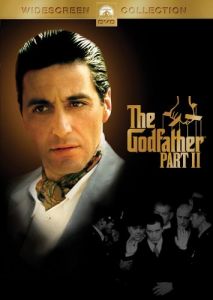
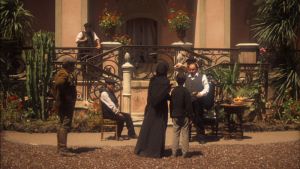

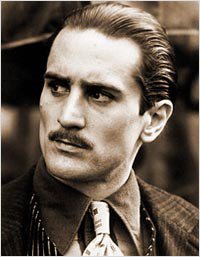
![] ]](http://www.dioenglish.com/wiki/uploads/201001/126476851749ffk3PL_s.jpg)
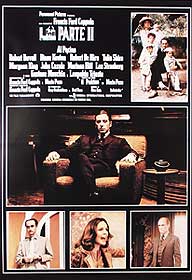
![]
]](http://www.dioenglish.com/wiki/uploads/201001/1264769117ib1frWMV_s.jpg)
